ED-TEC/Q-Speed is a collaboration between New Zealander, Leigh Michau, founder of Q-Speed and German, Michael Jost of start-up company eD-TEC.
The Current Status of Electric Boats
In the first of a two part series we look at the rapid evolution of the Inboard Electric Boat Propulsion phenomena in the recreational boating (and to a degree; commercial) marine industry both here in New Zealand and overseas. In part one we will delve into the background of this phenomena and in part two we will look more closely at Kiwi companies who are at the forefront of this technology.
By Ron Czerniak Marine Consultant
First off, let’s address the two big elephants in the room when it comes to discussing electric propulsion, whether land based (electric vehicles) or water based (electric boats), which is the theme of this article.
These two elephants are “Range Anxiety” and “Fuel Filling”.
I have been following electric vehicle development over the past decade, and ever since I picked up the book by Ashlee Vance about Elon Musk, I discovered that whoever you talk to, the first two issues of concern (our two elephants in the room) are “how far can I go on a full charge” and “where do I fill up when my fuel (batteries) get low?”
By the end of this article, those two elephants of concern will be reduced in size to a couple of wee mice in the room. Elephants dealt with, let’s move on.
But, before launching into this story, I thought to myself; “What do most people really even know about electric powered vehicles, never mind electric powered boats?” Therefore I’m going to start with some basics, believing that unless one understands the terminology, one cannot appreciate the product and what that product can and cannot do. I guess a bit like trying to explain philosophy to you in Greek when you only understand English.
The Terminology. Think of it this way. If you were to discuss a fossil fuel vehicle with just about anyone who has a car, they would probably grasp what you are telling them if you stated that your vehicle has a 2.0 litre, 4 cylinder engine, producing 160 horsepower, has 175 lb.ft of torque, can accelerate from 0 – 60 mph in 10 seconds, has an average fuel consumption of 8 litres/100 kilometres and full tank of fuel may get you from Auckland to Wellington without refueling.
Now, as the following terms will pop up from time to time, you may want to refer back to them as you read this article,
Energy is a measure of how much work it takes to do something. In the metric system it is measured in kilowatt hours (kWh). In the Imperial system in BTUs and otherwise.
Torque is the angular equivalent of force. In the metric system it is measured in newton metres (N.m). In the Imperial system in pound feet (lb.ft) and is a measure of how much a force acting on an object causes that object to rotate.
Thrust, that which makes your boat go, is a force (usually a push), measured in newtons (N) or pounds (lb). 4.45 newtons (0.453775 kilograms force (kgf)) of thrust equals 1 pound of thrust. Or, if you wish, 1 kilogram of force (kgf) = 2.21 pounds of force (Ibf)
Power is the rate at which work is done (or how much energy gets used how quickly). In the metric system it is measured in kilowatts (kW). In the Imperial system in horsepower (HP).
It is important to understand the difference between a kW (a measure of power) and a kWh (a measure of energy). Kilowatt-hours measure energy (e.g. how much charge is in a battery) and kilowatt measures power (how quickly the energy [charge] in the battery can be used). Since we’re talking about electrical inboards, its better that we use kW and kWh since these quantities are most commonly used throughout the electrical world.
So, if you’ve got a long way to go you need plenty of Energy (kWh or BTUs). But, if you want to go fast you need plenty of Power (kW or HP).
Horsepower, torque, speed, power, fuel consumption – what do all these really mean? Then there is the confusion between Imperial measurement and metric measurement. E.g. miles per gallon (mpg) versus litres per 100 kilometres. Or describing power in horsepower versus kilowatts. Arrrgh!
So, let’s try and keep it simple.
Fossil fuel versus Electric fuel
Fuel Tank = Batteries
Litres of Fuel = kWh of energy available
1 Horsepower = 0.75 kW approximately (or, If you prefer, 1 kW = 1.341 HP)
Therefore you may surmise that if a fossil fuel boat holds 100 litres of diesel and you burn 2 litres an hour at 10 knots; on a full tank you can run for 50 hours or 500 nm.
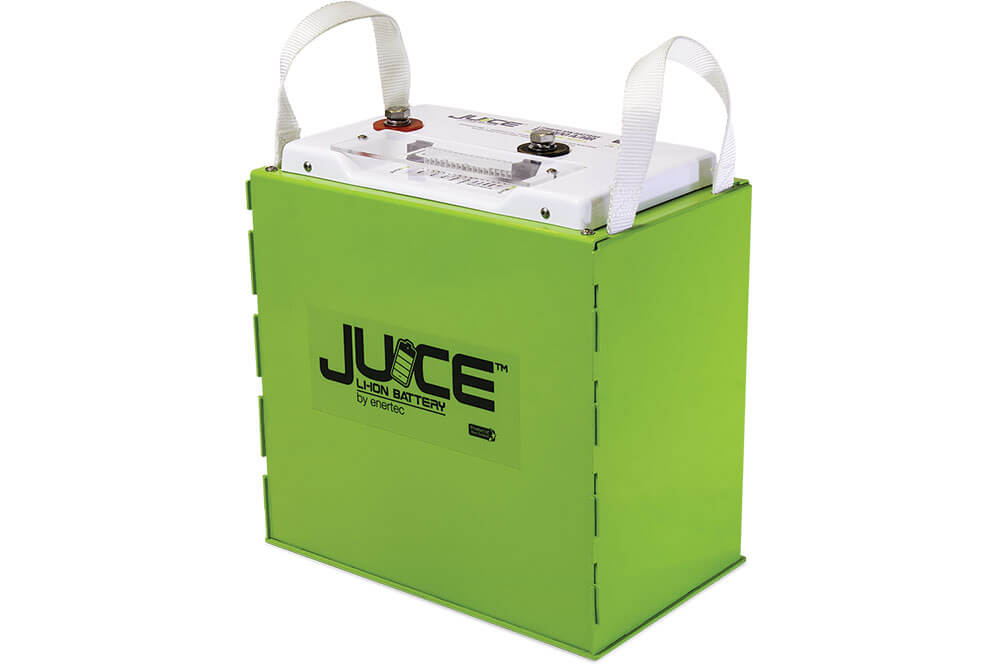
Batteries - Fuel
An electric powered boat is very similar. If you know your boat has 100 kWh of available energy in its batteries and you use 2kW at 10 knots; on a full battery you can run for 50 hours or 500 nm (assuming 100% efficiency).
But life is never that simple, right? True, but on the other hand, it isn’t that complicated either.
With an electric boat, our fuel source comes from batteries.
The number of electric motoring hours depends on your battery bank combined with any additionally generated capacity (from solar, wind, genset or other sources).
When shopping for a battery, there are four main categories:
Flooded lead acid: The most affordable are 6V deep cycle batteries, often used for electric golf carts, with a typical capacity of 200-250Ah. They are economical and are built for deep discharges. They need to be mounted upright and receive regular addition of distilled water. They also emit hydrogen gas when recharging. Not the most desirable marine option!
AGM batteries: are fully sealed, maintenance-free, handle high recharging current and can be mounted in any position. Relatively inexpensive, but won’t provide the “grunt” and capacity of Lithium-Ion batteries. Once again, not ideal for an electric powered boat.
Gel cells: are sealed, maintenance free, with a long lifespan allowing a large number of charging and discharging cycles. They are excellent as a service battery for medium and large systems.
Lithium type batteries in general, are top quality but most expensive, with highly advanced technology. They have a high energy density and are perfect for deep cycling applications. There’s also loads of types pf Lithium batteries: LiPO4, NMC, LTO etc etc. Each is quite different from the others. Compared to traditional lead-acid batteries, Lithium type batteries offer savings of up to 70 % in volume and weight, while the number of charging
cycles is three or more times as large. Therefore, most commonly used for inboard electrically propelled boats.
Charging Methods
Charging inboard motor boat propulsion batteries is, by and large, similar to charging electric vehicle batteries. However, the big difference is that the marine charging infrastructure is not yet as available as it is for land based electric vehicles; but we will get to that. Needless to say, batteries need to be charged as they get near empty, just as your current diesel engine fuel tank will need to be re-filled after a day out on the water. But more on that later as well.
What we really want to talk about is where the marine industry is as of today in terms of the practical viability of inboard electric boat propulsion for recreational and/or commercial use.
As I started to research this article I was amazed to discover how far the marine industry has come in such a short time in regards to actual electric boats already in day to day use, as well as being equally astounded by the plethora of new developments happening right now both locally and internationally. The tsunami of development all over the world necessitates a two part article. Therefore, for this first part, we will focus on what is happening right here in New Zealand using a handful of Kiwi companies to illustrate that, within a very short time, we will likely see as many inboard electric propulsion boats out on the water as we currently see land based electric vehicles out on our roads.
But before discussing some of the aforementioned companies, first a quick tutorial on the three main categories of electric boat options; not surprisingly, options similar to land based electric vehicles (EV’s).
Hybrid boats combine the benefits of diesel engines and electric motors. Capable of operating in a range of cruising modes, they can generally shift between electric and diesel mode.
Plug-in hybrid boats have both an internal combustion engine and a battery. While the hybrid boat’s battery and engine are connected, the plug-in hybrid’s systems operate separately and the batteries can be charged up at a marina (for example) after time out on the water.
BEB (Battery Electric Boat) – my own acronym, is a pure battery electric boat. Whereas a BEV in land based terms is a pure battery electric vehicle. These boats/vehicles are powered by rechargeable battery packs, with no secondary source of power. These boats/cars plug into an electricity source to recharge.
These distinctions are important when it comes to discussing electric boats and sometimes exact comparisons between boats and cars is not that straight forward, as we will learn.

Earthling (EV) Ltd, owned by John McGettigan, a passionate eco-warrior, who has understandably, pursued his interest in electric boat propulsion over the past two decades, forming strong relationships with cutting edge European EV producers.
The recently launched Earthling E-40 is a hybrid power catamaran which strives to offer a different experience, with large (unconventional), slow moving propellers driven by state of the art e-systems propelling highly efficient hulls. The E-40 is only the start, and will be part of a large family, with worldwide service and support from WhisperPower’s Piccolo DC range of compact marine generators, combining the latest diesel engine technology with a new way of producing electrical power on board.
The E40 will be a class boat with all builds identical, the only client options will be colour schemes and furnishings. The boat will include current innovations and, for the future, PectoFoil and Synfuel innovations are under development. Propulsion is provided by the safe, easily serviceable 48VDC motors from German start up Molabo, GmbH which reflect a huge technology leap in marine propulsion.
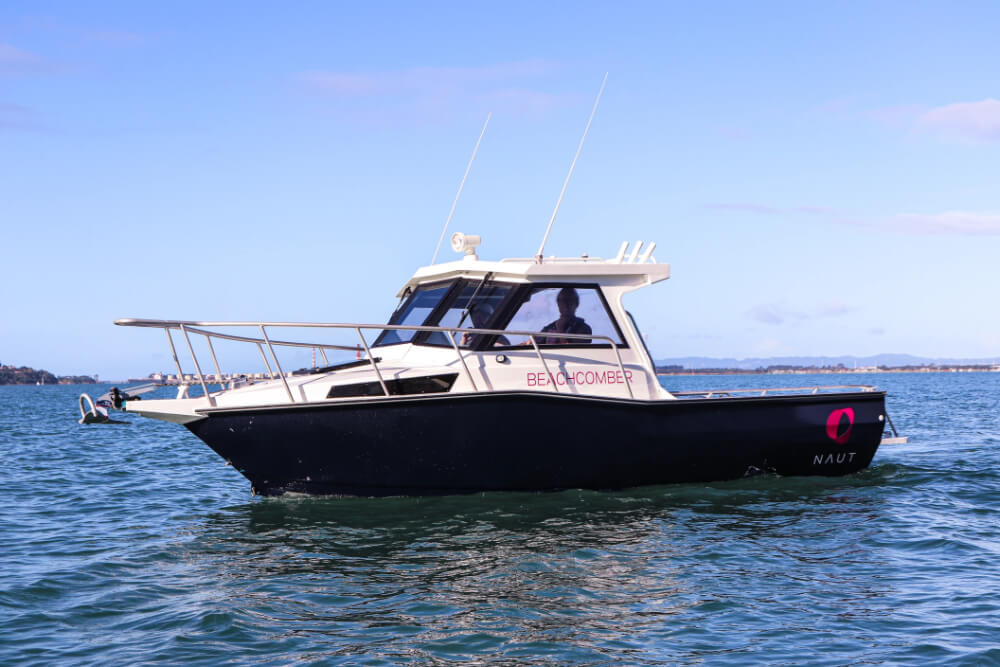
Naut Ltd (McKay) is a recently formed marine electric propulsion subsidiary company of McKay, based in Whangarei, New Zealand, established with the express purpose of primarily supplying retrofitted inboard recreational and commercial vessels in the 6 – 12m range. The Naut team have developed an electric propulsion system that can be sized to meet potential customer needs and works with any drive line: stern drive, shaft or jet (not to mention the Naut Electric Outboard, which is also available).
The first Naut inboard electric power vessel was the 25 year old Ramco trailer boat, Beachcomber. A 7m aluminium power boat that was originally powered by a Ford V8 5.0 motor and which is still fitted with the original, refurbished OMC stern leg. The
vessel represents another big step in Naut’s product development as the production team get closer to the delivery and production of fully electric propulsion products chiefly for the recreational marine sector.

‘Beachcomber’ comfortably reaches planing speed, with a top speed of 28 knots with a 150hp electric system.. The battery and propulsion system, comprising mainly ‘off the shelf’ componentry. The boat will accommodate overnight charging, from a standard home power point.
Not content to develop the aforementioned market in electric trailer boats, Naut has also signed an agreement with Shotover Jets for Naut to undertake a feasibility study to build a new fleet of electric jet boats. The initial scope of work will be for Shotover Jet’s fleet; however, the company is looking to convert all their jet fleet to electric, including Huka Falls Jet and Dart River Adventures.
McKay already has an established reputation in the design and co-manufacturing of ‘BEB’ vessels and last year they were instrumental in successfully launching the Wellington Electric Boat Building Company’s (WEBBCo.) fully battery electric ferry, “Ika Rere”, which now daily plys the Wellington harbour, supplying a regular service between Queen’s Wharf and Days Bay. I was recently fortunate to be able to take one of these daily trips and was, to say the least, impressed. More on this vessel will be discussed in part 2 of this series.

ED-TEC/Q-Speed is a collaboration between New Zealander, Leigh Michau, founder of Q-Speed and German, Michael Jost of start-up company eD-TEC. Between them and their ‘Believer Team’, they have designed and developed a system to offer an electric drive solution to the boating industry for vessels from small day boats and tenders to performance cruisers up to 30m.
“It is not just an electric inboard – it is complete plug and play, end to end technology stack (see image). There are lots of electric motors for boats on the market but not that many complete solutions and none that go as far as we do.”, says Leigh.

The eD-QDrive is based on an ultra-efficient mounting solution, simple plug-and-play drive interface and integrated technology backbone that extends from surface-drive propeller through the AI Box and battery bank to the helm interface.
The first eD-QDrive will debut in an 8.6 metre RIB with a range of 70 nautical miles at 30 knots. This system offers 100kW continuous power, which can be boosted to 200kW for a limited time, via a high C-rate battery bank scalable from 80 to 320kWh. A Cloud data analysis and a software-driven business model will allow for constant system updates and instant system upgrades.
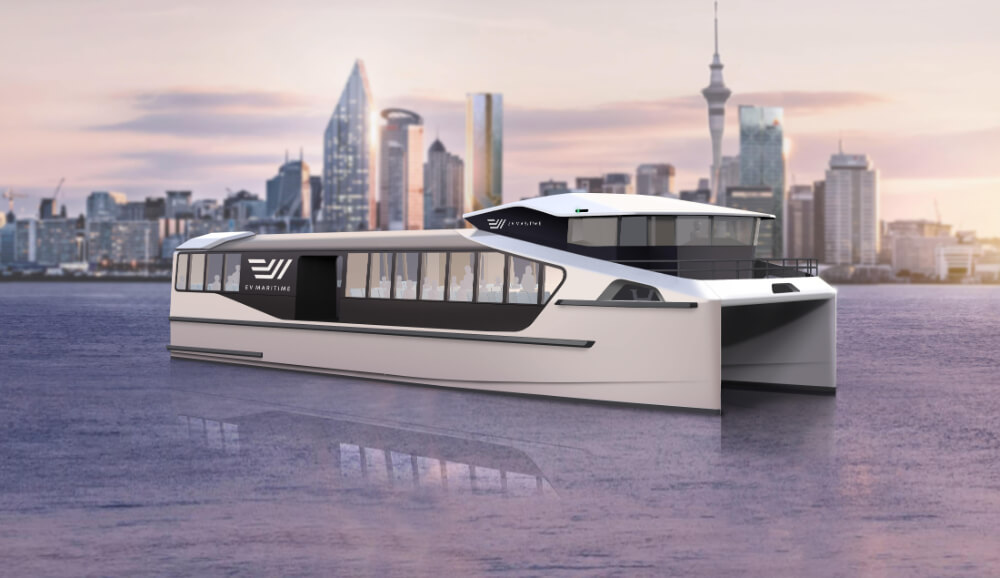
EV Maritime is currently building Auckland Transport’s first two electric fast-ferries, currently under construction at McMullen and Wing and due to be completed by mid-2024. is a design, engineering and technology company based in Auckland New Zealand. Michael Eaglin’s leadership of EV Maritime draws on over 25-years of marine industry experience and a personal passion for sustainability. The vessels are the first of the “EVM200” standardised 24m carbon composite catamarans, each with a fully loaded service speed of up to 25 knots and a capacity for up to 200 passengers seated inside. The vessels have been pro-actively developed by EV Maritime in compliance with Det Norske Veritas (DNV) classification for a global market applicability. The EVM200’s will be powered by over 1200 kWh of NMC lithium ion batteries for long range, running quad Hamilton Jet propulsion with Danfoss Editron permanent magnet electric motors and an extensive Programmable Logic Controller (PLC)-based integrated alarms, monitoring and control vessel management system with real-time ship-shore data transfer.
The first two Auckland vessels will operate from downtown Auckland Harbour and are likely initially to service Hobsonville and/or Half Moon Bay. Although the vessels are expected to be capable of delivering more than one trip on each charge, ultra-fast recharge at 2 MW at both ends of the planned routes is intended to enable the majority of recharge to occur during normal stops.
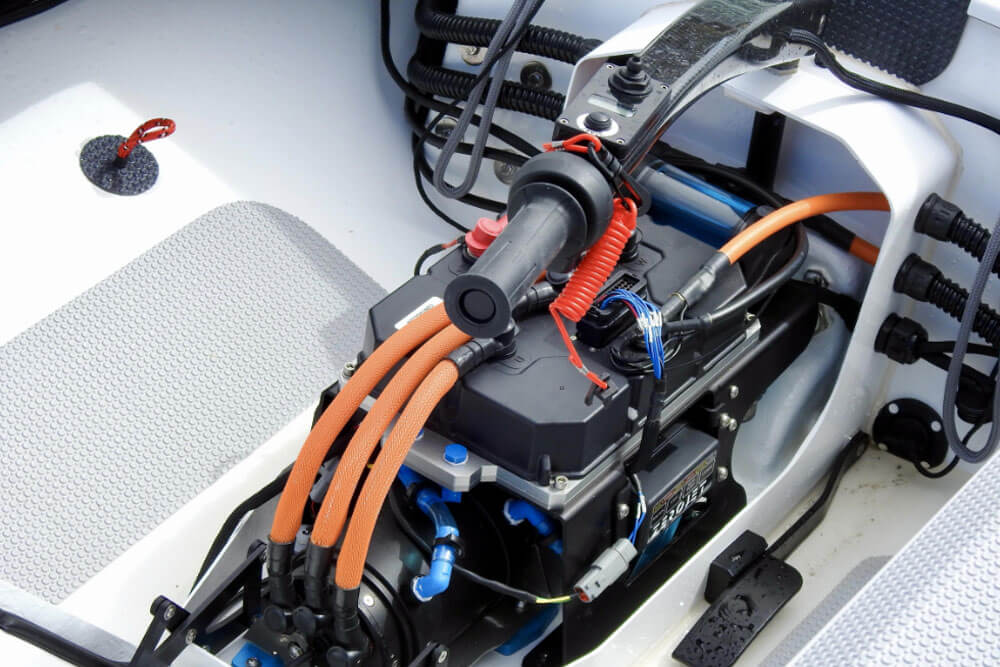
ZeroJet, yet another innovative New Zealand marine company, whose aim is to remove the need for ICE (Internal Combustion Engine) motors on new boats under 6m. With the launch of its 14 kW ZJ20 electric jet system Zerojet has gained traction in the international marine industry. Now, having successfully integrated its system into the OC Tender range, the production of these lightweight and versatile electric power boats is well underway.
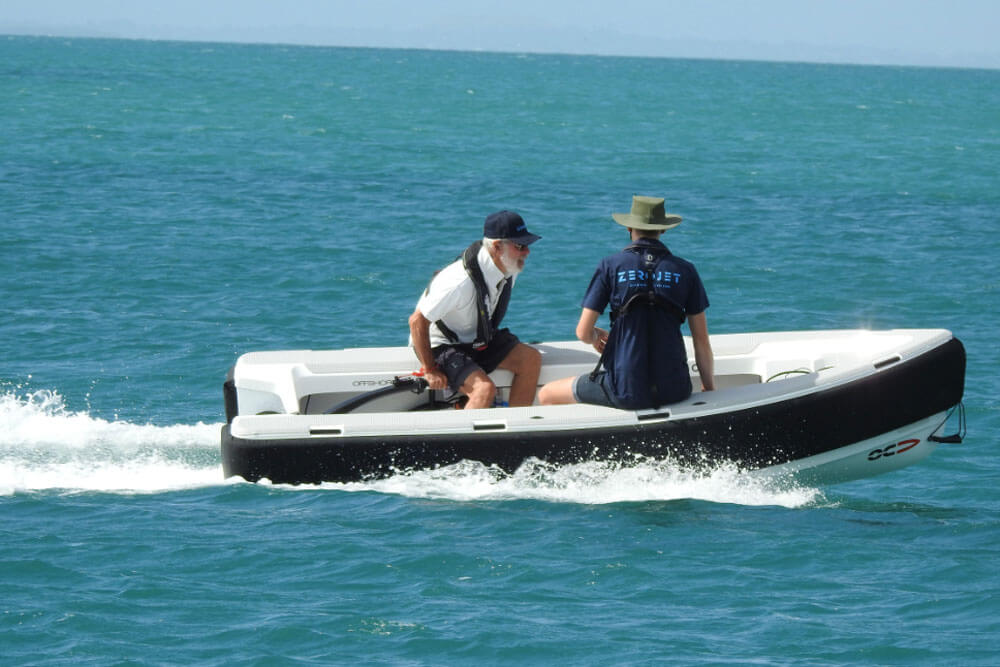
The ZeroJet OC Tender package offers superior manoeuvrability and enables these small craft to reach speeds of over 20 knots, offering fun, convenience and a greener solution than fossil fuel boats. Partnering with several international boat builder, ZeroJet can tailor its system to meet the individual needs of each vessel, ultimately providing a turnkey OEM solution to other boat builders.

Torqeedo, although not a Kiwi manufacturer, it is mentioned here simply because of the fact that they are an international company at the forefront of electric boat propulsion, both outboard and inboard and are strongly represented here in New Zealand through their distributor, Power Equipment, located on Auckland’s North Shore.
While Torqeedo is well known for their electric outboard motors, what is not so well known by many boating end users, is the fact that they are also at the vanguard of the design, manufacture and supply of inboard electric motors such as the Deep Blue system. With up to 100 kW the high-RPM version easily powers planing boats, while the low-RPM version is ideal for large yachts and other displacement vessels.
A fully integrated high-performance system for propulsion and energy management. More powerful motors and batteries open up new possibilities.
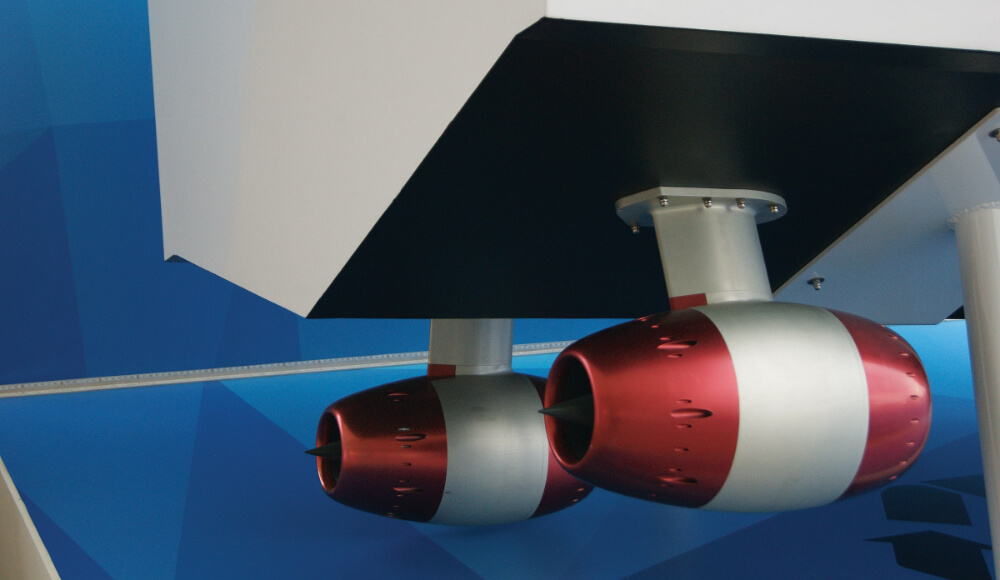
Sealence DeepSpeed is a truly innovative system. Auckland based JP Marine, the distributor for the Italian Sealence fully electric drive systems, have begun to fit to a unique 40 foot custom design boat with two Sealence drives.
JP Ribs are also involved with the implementation of an electric charging station marina in conjunction with the Queenstown City Council.
The Sealence DeepSpeed is a completely new marine jet propulsion unit with unprecedented performance in terms of more thrust at any speed, better efficiency and is extremely silent. In addition, it is a unique inboard/outboard system that brings substantial advantages in terms of installation and safety. It is both full-electric and hybrid. DeepSpeed is modular and the powertrain can be easily conjured to provide a bespoke system suited the customer’s specific needs.
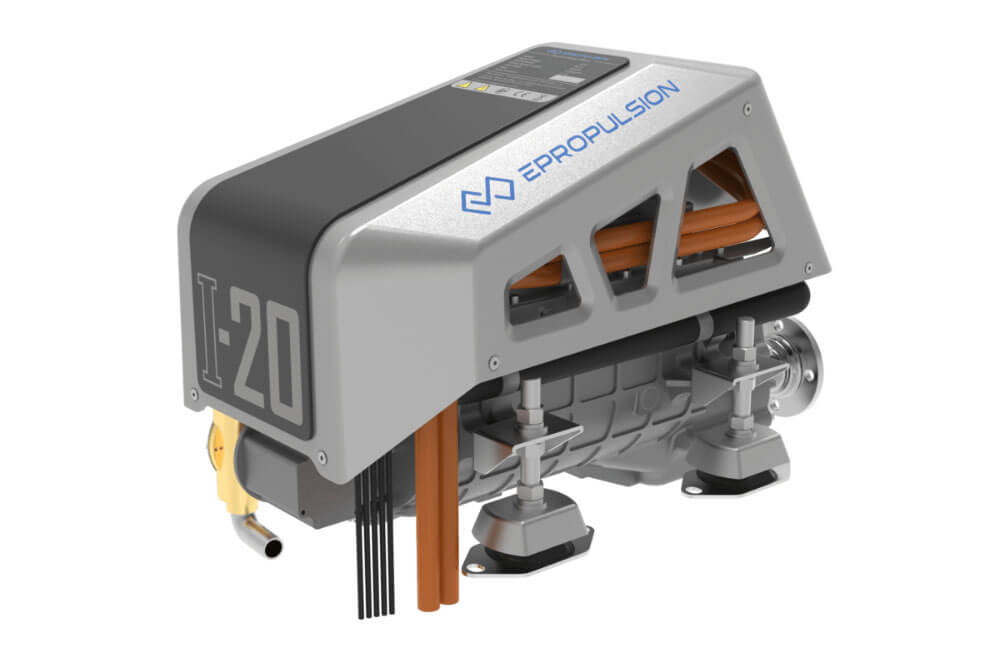
E-Propulsion recently introduced the I-Series of environmental-friendly electric inboard motors packed with innovative technology, smart features and human operation design. Underpinned by the highly integrated and modular ePropulsion Smart System Architecture (eSSA) and the IoT connectivity service, these motors provides users with an easy-to-use, intelligent, safe and reliable experience unlike any other. A compact design that integrates five functional modules of motor, gearbox, motor controller, system control unit and cooling system into a very small space.
There are three models in the range. The 10 kW I-10, the 20 kW I-20 and the 40 kW I-40. The first is air cooled and the latter two are water cooled with an option to be air cooled if necessary. In addition, E-Propulsion offer their H-100 (100 kW) electric inboard motor, engineered for larger sailing boats and motor vessels between 18-30m with a full displacement up to 200 tons.
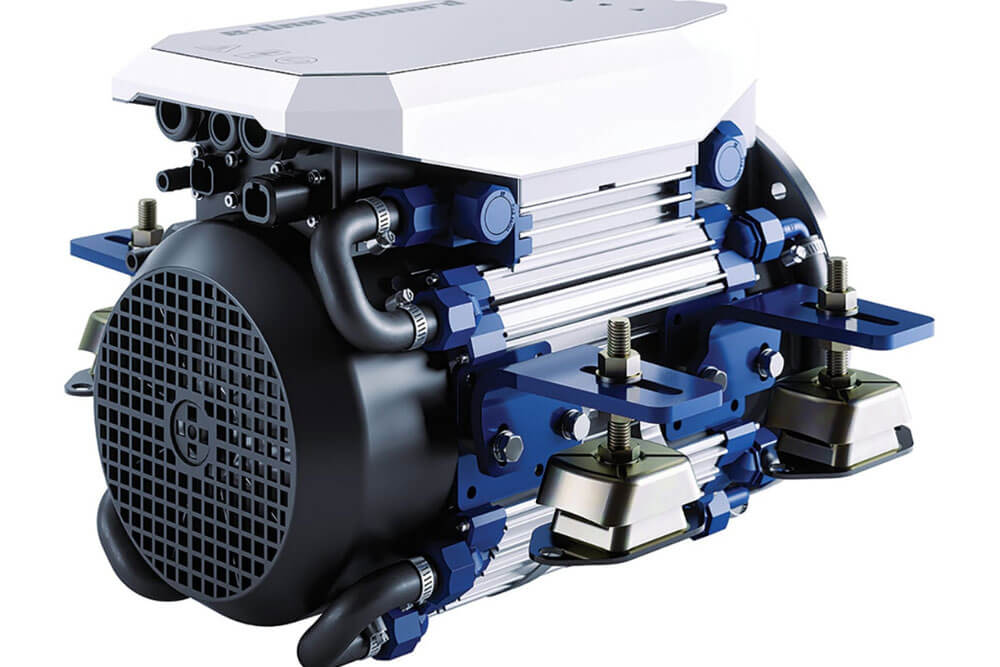
Vetus-Maxwell are household names for just about any Kiwi involved in boating. Graham Maxwell Cundy founded Maxwell in New Zealand over 50 years ago and the company, even though purchased by the well-known Dutch marine company, Vetus, over a decade ago, still has their head offices and manufacturing facility in Auckland.
Recently Vetus introduced their range of E-Line range of electric inboard motors. Suitable as both a re-power solution and for new builds, the compact and efficient 48V E-LINE packages enable silent, environmentally friendly cruising with exceptional manoeuvring capabilities.
The E-LINE features Vetus’s Active Electronic Braking, guaranteeing full control without the requirement of a gearbox and clutch. The high torque of the electric motor is used to change the direction of rotation quickly and actively, enabling the boat to be stopped within one boat length if necessary.
Remember those two elephants in the room? I think you will now agree, after reading this article, that they have been reduced to wee mice and, like land based electric vehicles, anxiety over range and charging your electric boat, if not already a thing of the past, will be soon. The future truly is here now.
In Part Two we look a little deeper at what is happening in the inboard electric market.




